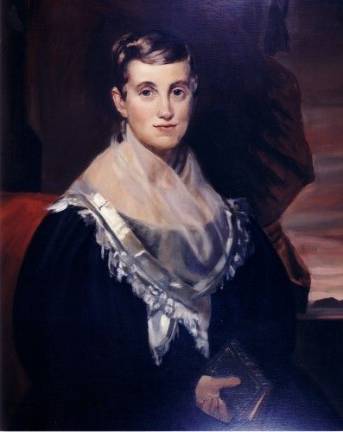Teacher who bucked 'Black Law' still inspires



By Geri Corey
GOSHEN — Bruce Crandall has filled notebooks with his impressive ancestry, starting eight generations ago with Elder John Crandall, born in 1616 in England or Wales, and continuing to the present day.
The former social studies teacher recently gave a talk, “The Prudence Crandall Connection,” hosted by the Orange County Genealogy Society. He is a direct descendent of John, the first Crandall to come to America. As a teacher in Farragut Middle School in Hastings-on-Hudson, Bruce first presented his talk on Prudence Crandall to his fifth-grade students in honor of Women in History Month.
“The Crandall family name isn’t that common, so it makes genealogy easier,” said Bruce, who lives in Goshen.
As the teacher credited for having the first integrated classroom in America, Prudence Crandall is an inspiring historical figure. But as the audience in the fellowship hall at the Goshen United Methodist Church learned, the Crandall lineage has more to boast about (see related story).
Disobeying the 'Black Law'Prudence Crandall, Elder John’s fourth great granddaughter, was born in Rhode Island in 1803. At age 17, she moved with her parents, Pardon and Esther Carpenter Crandall, to the small town of Canterbury, Connecticut. She attended the Friends Boarding School in Rhode Island, but later taught in Canterbury when she returned home.
Prudence was chosen to head a new school, the Canterbury Female Boarding School. Because she always wanted to own her own secondary school, eventually she purchased the school.
The school, which was actually a Federal style home, still stands today and is now a museum owned by the state of Connecticut.
Since she worked for Prudence, Mariah Davis, as Prudence’s first African-American student, attended school only part-time. Local residents had no problem with Mariah attending the school. However, when the second African-American student, Sara Harris, enrolled as a full-time student, townspeople raised objections.
Harris was the daughter of a free African American farmer who lived locally. In fact, she would have attended school in the same district as the white girls in the class.
Prudence refused to expel the girls from class, and parents of the white girls began removing them from school. Prudence temporarily closed her school and began recruiting African-American girls. With the help of William Lloyd Garrison, editor of the newspaper, The Liberator, who advertised for new pupils, African-American parents from Boston, Providence, New York, Philadelphia and surrounding Connecticut enrolled their daughters. On April 1, 1833, Miss Crandall’s School for Young Ladies and Little Misses of Color opened with 20 African-American girls. The cost: “$25 per quarter, one-half paid in advance.”
Unfortunately, local townspeople didn’t share Prudence’s enthusiasm for her new school. What started in Canterbury as town meetings and protests escalated into warnings, threats, and acts of violence against the school, like polluting the well with manure, shunning her in town, refusing to sell to her, and throwing stones at the building.
On May 24, 1833, the Connecticut legislature passed the “Black Law,” which prohibited a school with African-American students from outside the state without the town’s permission. By refusing to obey the law, Prudence was arrested and jailed for one night.
Disobeying the Black Law infuriated local residents, causing violence to heat up — stage drivers refused transportation, doctors wouldn’t see them, every ground floor window in the school was broken, and furniture was slashed. (There was even a fire, but officials were uncertain whether it was accidental.)
Knowing that she could no longer guarantee the safety of her students, Prudence closed the school and sent the girls home.
After two trials, no decision could be reached, so the case against Prudence was dismissed. Connecticut repealed the Black Law in 1838.
Prudence “did continue to teach all of her life, but she never ran her own school again,” Bruce said.
In Aug. 1834, she married the Rev. Calvin Philleo, an iterant Baptist minister. Prudence educated his three children from a previous marriage. The family moved around a great deal, going from Massachusetts to New York to Rhode Island, and to Illinois, where the Rev. Philleo died in 1874. The widowed Prudence Crandall — she resumed her unmarried name — moved with her brother Hezekiah to Elk Falls, Kansas in 1877. Prudence died there and was buried in the Elk Falls Cemetery in 1890.
Connecticut's heroineIn 1995, the Connecticut General Assembly named Prudence Crandall as the “state’s official heroine.” Fourth–grade students who visited Hartford noticed that although there was a statue of Nathan Hale, the “state’s official hero,” there was none of Prudence. They launched a “Pennies for Prudence” campaign to erect a statue. In 2009, a statue representing Prudence and a pupil was installed in the state capital.
Prudence Crandall was the subject of a Disney movie, “She Stood Alone,” that was based on "A Whole-Souled Woman: Prudence Crandall and the Education of Black Women," a book written by Susan Strane.
“I’m proud to have Prudence as an ancestor,” said Bruce, concluding his talk. “I’m very proud. She’s a tough act to follow. She’s a fascinating person. If I could meet anyone from the past, I’d like to meet Prudence.”